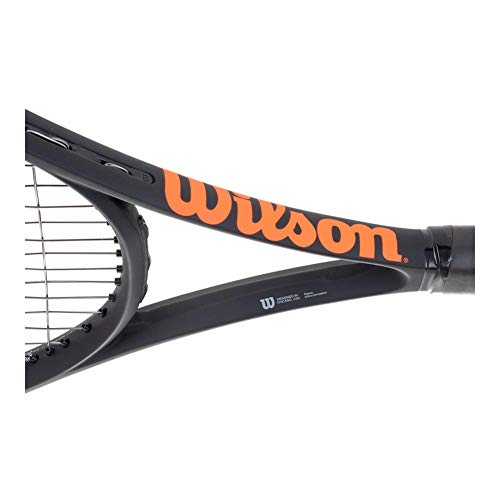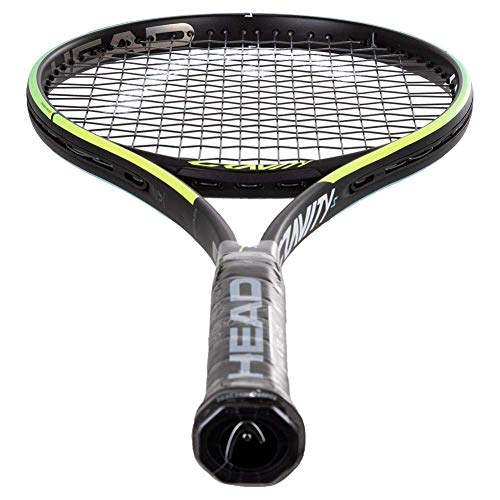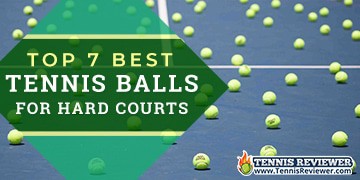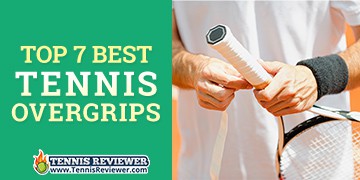Sometimes as tennis fans, we tend to want to play with the rackets we see the best playing with. However, playing with Federer’s Pro Staff may cause more damage to those who are prone to injury.
It’s not because the racket isn’t great but more so that the weight, stiffness, balance, among other factors, may not provide the extra comfort someone needs when dealing with arm injuries.
This list will not only give you the top 5 arm friendly rackets for 2022 but also explains what makes a racket friendly for the arm or not.
Here is what you need to know.
Table of Contents
In a Hurry? Here’s Our Top Picks…
How to Choose An Arm Friendly Racket
Choosing a racket can be overwhelming as there are so many different specs on a racket that change how it swings, feels, and hits. All of these factors can send different levels of shock to one’s arm. While some rackets are definitely friendlier than others, all racket manufacturer companies are trying to come up with solutions to limit the vibrations.
The weight of the racket can determine two different factors. A light racket provides less stress but can also sometimes move too much in your hand depending on the balance, causing some shock and unstableness.
Different elbow and joint pain can also come from the level of stiffness a racket has to offer, which is calculated through an RA rating.
By figuring out some of these factors and choosing a racket that is soft on your body, you’ll be able to play longer and not have to worry as much about long term injuries.
Below has everything you need to know when choosing a racket that feels good and hits well!
Four Types of Rackets
There are essentially four groupings of rackets that manufacturers make tailored to three different styles of player. Each one has an impact on the arm.
The groupings go from power rackets, modern rackets, tweener rackets, and lastly, traditional players rackets. Each racket has it’s own specs and would be more or less stiff, weighted, etc., based on the result it is aiming for.
In general, each racket can be customized to provide extra comfort to the arm, but tweener rackets tend to take the cake, whereas traditional rackets tend not to be arm-friendly.
Power Rackets:
Power rackets can be an excellent option for arm friendly rackets as they usually are oversized in their dimensions, which means there is a bigger sweet spot. Bigger sweet spots mean more forgiving contact and fewer vibrations.
Despite these slightly bigger rackets in specs, they tend to be the overall lighter rackets than some other options. Lighter rackets sometimes are great for length of playing and stress but may cause a little bit of instability depending on the weight balance.
Modern Racket:
A modern racket is very similar to a tweener racket that falls into the mid plus size of rackets. This means the sweet spot will remain relatively fair in size and allow for power in a lightweight racket. These rackets depending on the other specs, can also offer arm friendly solutions.
Traditional:
Traditional rackets typically are not arm friendly as they are really geared towards professional tennis players. They are the smallest in frame size and tend to be really heavy.
The benefit to the heavy part of the racket is that while it won’t help in endurance, it will assist in less shock and moving around in the hand. However, they also tend to be stiffer rackets, and stiff rackets transmit vibration into the arms.
Tweener:
Tweener rackets are the rackets that are right down the middle in all the specs. They tend to be medium to heavy rackets, which can affect the arm but sometimes come in lightweight feel and swing feels.
Tweener rackets have become a fan favorite because you can save your arm while not having to give away power and control.
Weight
The weight of a racket has a lot to do with how your arm is going to feel. Heavyweight rackets will transmit less shock and vibration and add more stability to the contact.
There are two things that come to mind with heavy rackets.
The weight may be bothersome to anyone at first, and if you are injury-prone, then going to a weight that is too heavy will only make arm pain more prominent. This is different than arm soreness. If you are a younger player that is growing and advancing in tennis, it is normal to feel sore from a weight change upwards. Eventually, this will be fine if it’s incremental.
While it will transmit less shock, it’s essential to consider your form. Bad technique and the added weight are a terrible combination. This is where injuries develop over time and can be problematic.
Lightweight rackets like the tweener and power rackets are great for maneuverability and endurance with the arm but can be a little less stable in one’s hand. These rackets may be recommended for older adults as it limits the weight strain put on arms and wrists.
Head Size
Head size has to do with the racket’s sweet spot, which means that the bigger the head size, the more forgiving the feel will be and ultimately feel better for your arm.
A bigger sweet spot makes the difference because, for those who don’t hit quite on center, it won’t feel as smooth and will give a pang kind of feel. This is what leads to arm pain.
The head sizes can be divided into four categories ranging from small to large.
- Midsize
- Mid-Plus Size
- Oversized
- Supersize
Midsize:
This is the smallest racket head size there is out there and offers a lot more control than power. It also will be a racket that has a smaller sweet spot. Most of the rackets do offer vibration technology for comfort.
The frame itself is 84-97 square inches. These rackets may be geared towards more advanced players and players on tour.
Mid-Plus Size:
Mid-plus is an excellent option for those who fall in the intermediate to advance category but deal with a lot of arm pain. The increase in sweet spot helps with the shock transmitted without giving away too much control.
This racket frame is 98-105 square inches.
Oversize:
Oversize is geared more towards the older crowd and beginners. These rackets tend to be super lightweight and very large in frame size. Having said that, it’s your second-best option for severe arm pain.
The larger head size will forgo a lot of your control, and the dimensions for oversize rackets are 107-115 square inches.
Supersize:
These are much less common on the tennis scene and mostly sold to a much older crowd. While it comes first in arm comfort as it’s the largest sweet spot possible, it may not work for regulation.
Keep in mind that rules state that the racket head size can not exceed 12.5 inches in width and 15.5 for the hitting surface area.
String Tension
Going with the recommended string tension range will definitely assist in easing up on the arm. A general rule of thumb to follow with arm pain is that a looser strung racket towards 50 pounds will have more absorption and less shock.
The tighter a racket is strung, the more strain that comes from having to hit the ball harder and the fact that a player will feel the ball a lot more. Control is great, but it also comes at the price of sending more vibrations to the arm.
Balance
The balance of a racket comes in three different options. Head heavy, equally distributed, and head light. This is where the weight is distributed. This plays a major role in arm friendly rackets as the weight distribution can do a few different things.
Head Heavy rackets put all the weight towards the top of the racket. This adds power but also can cause sore arms because it’s much harder to maneuver a racket that has most of its weight at the top farthest away from the handle. This is where bad technique is a no-go and the weight of the racket.
Head heavy is beneficial because the racket’s overall weight tends to be decreased, and because of the weight being where the ball is hit, less vibration occurs.
Equally distributed rackets are just like the tweener rackets and will offer you the best of both worlds. This is a great choice for those who don’t want to lose power, control, feel, but may still have some arms soreness here and there. It’s a great option that somewhat eliminates the negatives of both of the other options.
Head Light rackets are the exact opposite to head heavy rackets, with all the weight being distributed to the handle. The maneuverability increases both the shock and pang of the ball at the top of the racket, which can cause elbow and arm soreness really easily. Head light rackets are heavier in general, so this is not a great option for anyone looking for an arm friendly racket.
Stiffness
The stiffness of a racket also plays a considerable role in arm pain and arm friendly rackets. The stiffness is exactly what the title is. How stiff a racket is when contact is made with the ball.
The racket will bend forward and backward more if it has a more flexible frame. This isn’t something you can see but rather something you can feel. A stiff racket will send shock to your arm, where a flexible racket will absorb some of the impact.
The stiffness is measured from 50-70 RA. This number is done by the manufacturers and can let anyone know what they are buying.
The Top 5 Best Tennis Rackets 2022
That may feel overwhelming based on the information listed above, but don’t let it deter you. Once you get the hang of understanding what makes a racket more of less arm friendly, it’s really easy.
What’s better is that all manufacturers will list all the specs either both on the racket and website or at the very least on the website. Even better, a racket website will usually point towards describing whether it is an arm friendly racket or not, making things a lot easier.
That’s not always the case, though, so that’s why this top 5 list of arm friendly rackets will serve you well. Pun intended.
1. Wilson Clash 100
The Wilson Clash is one of the best rackets for preserving the arm due to its flexible, lightweight frame and its Freeflex and Stablesmart technology that Wilson incorporated.
The freeflex technology works so that the frame bends perfectly upon contact giving you the forgiving feel of a great sweet spot. It’s paired with Stablesmart technology that reduced the vibration and shock that comes from a lighter racket.
It’s lightweight and is very maneuverable as it weighs under 11 ounces when strung. This allows players to swing freely, feeling confident they can have power, control, and comfort in the arm.
The Breakdown:
- Wilson prides itself on this racket being 215% more flexible than the next leading racket.
- It’s a 100 square inch frame making it a great in-between racket.
- It’s 55 RA stiffness rating pulls in at the lower side.
- Its swing weight is 312 grams matching the exact strung weight so that it feels just as it really is.
2. Yonex EZone 98 Racket
This edition of the finest arm-friendly racket offers explicit stability and power, which is just what you will need when choosing a tennis racquet to prevent a tennis elbow. The string pattern comes with a conventional 16×19 set on a 98-square inch racquet head. Although it seems to be small, you don’t have to worry whether you will be able to perform complex and powerful shots with it.
It comes with an advanced swing weight of just around 317 pounds which means you will be able to be precise, powerful, and play with comfort all at the same time. Made with cutting-edge technology, the Yonex Ezone 98 is a racquet suitable for beginners, intermediate players as well as those who’ve been in the game for years and play professional tournaments.
It is the Yonex Dual Shut System and the featured rating of 63, which offers a superb advantage in terms of comfort. Not only that, but the sophisticated design and the HM Graphite structure go a long way in terms of allowing great control while minimizing everyday tear/wear. To get the most out of the Yonex EZone 98, you should pair it with natural gut strings and get on the tennis court today!
The Breakdown:
- Offers great control accompanied by a flex rating of 63
- Comes in a variety of grip sizes
- Suitable for beginners, intermediate and professional players
- Comes with a Yonex Dual Shut System for added comfort
- YONEX EZONE 98: The Yonex EZONE 98 deep blue tennis racquet is for intermediate to advanced players looking to dominate with controllable power and comfort.
- RACKET FEATURES: According to Yonex, the updated Ezone 98 will absorb 7.9% more shock and increase ball speed by 2.5% compared to the previous model. The Ezone 98 is 10.8 ounces unstrung and has a spin-friendly 16x19 string pattern.
Prices pulled from the Amazon Product Advertising API on:
Product prices and availability are accurate as of the date/time indicated and are subject to change. Any price and availability information displayed on [relevant Amazon Site(s), as applicable] at the time of purchase will apply to the purchase of this product.
3. Prince Phantom 100G
For a slightly heavier option, the Prince Phantom100g comes in at 11.4 ounces strung. This racket, in particular by Prince, has great playability and is known for its crossbar.
This unique feature gives the racket significantly more stability by balancing the frame with a connecting bar between the throat of the racket on either side. It’s 16×18 string pattern, and 100 in square head size offers both power and control from all areas of the court.
Its maneuverability is fantastic and, with a low stiffness rating of 59, makes it super arm friendly. Its stability comes from the Anti Torque system, which is a combination of Textreme and Twaron in the throat of the racket and at 10 and 2 in the hoop of the racket.
This is a great option for those who need an arm friendly racket but want to have the feel of an intermediate or advanced racket.
The Breakdown:
- Swing speed is fast, with a swing weight of 318 grams.
- A standard 27 inches in length and 100 square inches in head size.
- A lower RA stiffness rating of 59 despite the great feel and power that exudes off this racket.
- It has a lower recommended tension range of 45 to 55 pounds.
- A modern classic, the Phantom 100G will feel familiar to all prince fans with the iconic cross bar design paying homage to the greatest of all time, the Graphite. The Phantom 100G brings a modern twist to that classic by dialing up the feel thanks to the super thin 20-16mm CTS construction and bringing 21st century speed thanks to a lower swing weight which makes this racquet a perfect ally either when attacking or on defense.
- Head Size: 100 sq. in. / 645 sq. cm.
- Length: 27 in.
- Strung Weight: 11.5 oz. / 326 g. Unstrung Weight: 11.1 oz. / 315 g.
- String Pattern: 16 Mains x 18 Cros
4. Head MicroGEL Radical Midplus
The HEAD MicroGEL Radical Midplus is a version of the radical than was made for those who need arm friendly support. The MicroGEL technology is placed throughout the racket in the frame and in the throat to offer a softer contact.
The way it works is that the microgel will compress and decompress on contact to absorb the vibration and provide a solid contact feel.
The flex to the hoop also is quite noticeable among players and is greatly appreciated when making contact. Its swing weight is 315 grams makes it feel like it’s maneuverable and solid at the same time.
Its stiffness level is low at 62, which provides the flex but its power level is low, allowing a player to really swing free and full, creating their own power.
The Breakdown:
- It’s 98 square inches head frame makes it a slightly smaller headsize than some of the other arm friendly rackets.
- It weighs in at 11 ounces and has a slightly higher swing weight of 315 grams.
- Its recommended stringing tension is 52-62 pounds putting it at a more normal range because of its microGEL tech.
- Its stiffness rating comes in at 62, making it slightly stiffer than some of its other competitors.
- For aggressive players with hard strokes
- 98 head, 11.1 oz strung, 3 points head light, 18 x 20 pattern
- For all court Play
- Cover for one racket. Shoulder Strap. Lightly padded to Prot
5. Volki V Sense Pro V1
The Volki V Sense Pro V1 Pro is a hidden gem that not many people know about. It’s newer to the market, but no amateur with its specs. The 99.5 square inch head size powered with an 11.3 strung weight makes it arm friendly and feels as good as the other rackets.
The Volki rackets are developed to assist those with arm injuries with no real category sticking out over another. This increases the playability of the racket. The maneuverability is incredibly high but sometimes may result in a little bit of unstableness.
This provides long-term comfort to the arm but may have a little shock from off-center hits on contact. Its swing weight comes in at 317 grams, which actually makes it feel lighter than it is. But not by much.
It’s a head light racket but not by much, with only 3 balance points head light. This is what makes the racket so easy to swing fast, and while it may be slightly heavier, the weight is in the right place for arm-friendly swinging.
The Breakdown:
- A different frame size of 99.5 square inches puts it right in the middle of the mix.
- The weight is 11.3 with string but has a lighter swing weight of 317 grams, increasing maneuverability.
- 16×19 mains and crosses is the string pattern.
- It’s rated pretty well on all aspects of power to maneuverability, not really shining in one category over another.
FAQ:
Even with these recommendations, it’s normal to still have questions. This FAQ section will seal the deal by giving you the answer you need to comfortably make a decision.
While all the rackets listed above are great choices, the smallest differences can make a person feel strongly for one racket over another.
Read on to really know everything you need to about arm friendly rackets.
What is the life expectancy of a racket?
The USTA will tell you that a racket can last around two years. This answer can really vary depending on the frequency you play and how you treat your racket.
Every time you string a racket, it pulls on the frame and starts to warp it.
Knowing the life expectancy of a racket is important for your arm health because the more a racket changes, the less arm friendly it can be than when you originally bought it. The balance can change, and the way the string can pull a frame can change the sweet spot.
It’s always a good idea to maintain your racket and pay attention to when it starts to feel funny. If you have been playing with it for a while and you start to develop pain, the life expectancy may be coming to an end.
Does it matter which strings I string my racket with?
Strings play a huge role in arm pain and management. The stiffer and harder the strings are, the worse it will be for your arm. The downside to soft strings is that it is more likely to break the more often you play and the more advanced of a player you are.
Having said that, soft strings provide awesome feel. They also provide awesome feel for your arm and can be a little bit costly, which sometimes can be a downer because of the frequency in which they break. However, it’s worth the investment.
Natural gut is one of the best options for soft-on-the-arm type of string. The downside to this is that it is also one of the most expensive strings out there to purchase.
What are the weight classes of rackets, and how does it affect my arm?
Each racket type will have 3 or more weight classes for a player to choose from. For example, the HEAD Gravity will have the S, MP, MPLite, Pro, etc. These weight classes change the overall string weight of the racket but not much else.
However, some racket’s stiffness may change among class levels to offer more control as the weight goes up. For instance, the Yonex 100 is more flexible than the Yonex 98.
The heavier a racket is, the more strain it could have on your arm. Same with stiffness as the stiffer a racket is, the worse it will be for your arm’s health. However, a heavier flexible racket can be a good combination in staying stable and adding power so that a player doesn’t have to produce too much of their own.
The weight distribution, for the most part, will remain the same within a model.
How do I know which tension to string my racket at?
A racket manufacturer will list the range online and sometimes even on the racket. Keep in mind the lower in tension you go, the better it is for your arm. Loose strings allow for more absorption, while stiff strings offer more control.
It’s best to tamper with a tension that both finds comfort and control as most players have their own preference. A tension preference may also change time to time depending on the conditions one is playing in.
What is the recommended level of stiffness for players?
The lower the stiffness rating, the better it is for the arm. However, some people don’t like the lack of control that comes with the flex. Finding somewhere between 50 and 60 is generally a good range for players who struggle with arm issues.
Conclusion
It might seem like there’s a lot to think about when it comes to arm health and choosing the racket. You aren’t wrong if that’s where you are at. However, a lot of the information plays together and starts to make sense once you learn it.
Arm friendly rackets should have a counteract category if one spec seems to not be arm friendly. For instance, if the racket is heavy, then it should not also be stiff.
Any of the rackets listed above will do just great in protecting your arm.

































